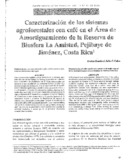| dc.description.abstract | Una caracterización biofísica y socioeconómica de los sistemas agroforestales con café en Pejibaye de Jiménez, Costa Rica fue hecha con base a entrevistas de productores en 27 fincas seleccionadas por muestreo al azar estratificado. La evaluación biofísica se realizó con parcelas temporales circulares de 10 m de radio (314 m2). Se identificaron 14 sistemas agroforestales, donde los más representativos fueron el café asociado a: 1) todos los componentes (palmas, fijadoras de N, maderables, musáceas) 2) todos los componentes excepto palmas 3) especies fijadoras de N, maderables y musáceas 4) especies fijadoras de N, musáceas y otros componentes y 5) especies fijadoras de N, maderables, palmas y musáceas. Se identificaron 34 especies de malezas, cinco enfermedades y una plaga. Después de la caída de los precios del café en 1997, se redujo la intensidad del manejo del cultivo, reduciendo la productividad promedio de café de 3680 a 920 kg/ha/año. Un 55 por ciento de los productores estuvo considerando cambiar de actividad productiva a menos que se les presenten alternativas económicamente viables. A biophysical and socioeconomic characterization of the coffee agroforestry systems in Pejibaye de Jiménez, Costa Rica was based on interviews of farmers in 27 farms selected through random stratified sampling. The biophysical evaluation was made in temporary circular plots, with 10 m radius, were used. 14 agroforestry systems were identified, the most respresentative being coffee associated with: 1) all components (palms, N fixing, timber and Musa spp. 2) all component except palms 3) N fixing species, timber and Musa spp. 4) N fixing species, timber, palms and Musa spp, 5) N fixing species, timber, palms and Musa spp, 34 weed species, five diseases and one pest were identified. After the fall in coffee prices in 1997, most farmers reduced management intensity and consequently coffee productivity decreased from 3680 to 920 Kg/ha/year. Most farmers (55 percent) were considering a change from coffee farming to another prouctive activity if they could identify and economically viable alternative. | es_ES |


